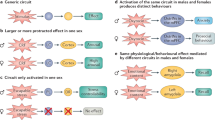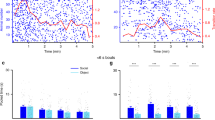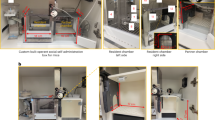Abstract
Given both the high prevalence of anxiety disorders in women and the fact that little is known about the mechanisms of gender differences in anxiety, our primary aim in this study was to investigate the neurobiological mechanisms underlying sex differences in social anxiety-like behavior in rats. Through the use of zif268 antisense oligodeoxynucleotides (zif ASO), we induced a temporary downregulation of zif268 expression in the medial prefrontal cortex of male and female rats and found that zif268 ASO male rats show more social anxiety-like behaviors when compared with control male rats in the social interaction test. In fact, zif268 ASO males displayed social anxiety-like behaviors, which were similar to control females, thus downregulation of zif268 expression in the mPFC of male rats eliminated sex differences previously found in the social anxiety-like behavior tests. Interestingly, zif268 ASO in female rats had no effect on their social interaction. Our novel findings have led us to ascertain that sexually dimorphic zif268 expression in the mPFC is a key molecular factor in mediating sex-specific anxiety-like behavior in the social interaction test.
Similar content being viewed by others
Log in or create a free account to read this content
Gain free access to this article, as well as selected content from this journal and more on nature.com
or
Accession codes
References
Anderson SW, Bechara A, Damasio H, Tranel D, Damasio AR (1999). Impairment of social and moral behavior related to early damage in human prefrontal cortex. Nat Neurosci 2: 1032–1037.
Barrash J, Tranel D, Anderson SW (2000). Acquired personality disturbances associated with bilateral damage to the ventromedial prefrontal region. Dev Neuropsychol 18: 355–381.
Bechara A, Damasio H, Damasio AR, Lee GP (1999). Different contributions of the human amygdala and ventromedial prefrontal cortex to decision-making. J Neurosci 19: 5473–5481.
Best NR, Rees MP, Barlow DH, Cowen PJ (1992). Effect of estradiol implant on noradrenergic function and mood in menopausal subjects. Psychoneuroendocrinology 17: 87–93.
Bjorn I, Sundstrom-Poromaa I, Bixo M, Nyberg S, Backstrom G, Backstrom T (2003). Increase of estrogen dose deteriorates mood during progestin phase in sequential hormonal therapy. J Clin Endocrinol Metab 88: 2026–2030.
Bozon B, Davis S, Laroche S (2003). A requirement for the immediate early gene zif268 in reconsolidation of recognition memory after retrieval. Neuron 40: 695–701.
Brayer KJ, Segal DJ (2008). Keep your fingers off my DNA: protein-protein interactions mediated by C2H2 zinc finger domains. Cell Biochem Biophys 50: 111–131.
Cole AJ, Saffen DW, Baraban JM, Worley PF (1989). Rapid increase of an immediate early gene messenger RNA in hippocampal neurons by synaptic NMDA receptor activation. Nature 340: 474–476.
Cummings JA, Brizendine L (2002). Comparison of physical and emotional side effects of progesterone or medroxyprogesterone in early postmenopausal women. Menopause 9: 253–263.
Davis HP, Squire LR (1984). Protein synthesis and memory: a review. Psychol Bull 96: 518–559.
Edwards DA, Pfeifle JK (1983). Hormonal control of receptivity, proceptivity and sexual motivation. Physiol Behav 30: 437–443.
File SE, Seth P (2003). A review of 25 years of the social interaction test. Eur J Pharmacol 463: 35–53.
Fumagalli F, Franchi C, Caffino L, Racagni G, Riva MA, Cervo L (2009). Single session of cocaine intravenous self-administration shapes goal-oriented behaviours and up-regulates Arc mRNA levels in rat medial prefrontal cortex. Int J Neuropsychopharmacol 12: 423–429.
Gater R, Tansella M, Korten A, Tiemens BG, Mavreas VG, Olatawura MO (1998). Sex differences in the prevalence and detection of depressive and anxiety disorders in general health care settings: report from the World Health Organization Collaborative Study on Psychological Problems in General Health Care. Arch Gen Psychiatry 55: 405–413.
Goelet P, Castellucci VF, Schacher S, Kandel ER (1986). The long and the short of long-term memory--a molecular framework. Nature 322: 419–422.
Gonzalez LE, Rujano M, Tucci S, Paredes D, Silva E, Alba G et al (2000). Medial prefrontal transection enhances social interaction. I: behavioral studies. Brain Res 887: 7–15.
Hebb MO, Robertson HA (1997). Coordinate suppression of striatal ngfi-a and c-fos produces locomotor asymmetry and up-regulation of IEGs in the globus pallidus. Brain Res Mol Brain Res 48: 97–106.
Jaskiw GE, Weinberger DR (1990). Ibotenic acid lesions of the medial prefrontal cortex potentiate FG-7142-induced attenuation of exploratory activity in the rat. Pharmacol Biochem Behav 36: 695–697.
Johnston AL, File SE (1991). Sex differences in animal tests of anxiety. Physiol Behav 49: 245–250.
Kabbaj M, Devine DP, Savage VR, Akil H (2000). Neurobiological correlates of individual differences in novelty-seeking behavior in the rat: differential expression of stress-related molecules. J Neurosci 20: 6983–6988.
Kessler RC, McGonagle KA, Zhao S, Nelson CB, Hughes M, Eshleman S et al (1994). Lifetime and 12-month prevalence of DSM-III-R psychiatric disorders in the United States. Results from the National Comorbidity Survey. Arch Gen Psychiatry 51: 8–19.
Koss WA, Gehlert DR, Shekhar A (2004). Different effects of subchronic doses of 17-beta estradiol in two ethologically based models of anxiety utilizing female rats. Horm Behav 46: 158–164.
Lacroix L, Spinelli S, Heidbreder CA, Feldon J (2000). Differential role of the medial and lateral prefrontal cortices in fear and anxiety. Behav Neurosci 114: 1119–1130.
Lisman JE (1999). Relating hippocampal circuitry to function: recall of memory sequences by reciprocal dentate-CA3 interactions. Neuron 22: 233–242.
Malkani S, Wallace KJ, Donley MP, Rosen JB (2004). An egr-1 (zif268) antisense oligodeoxynucleotide infused into the amygdala disrupts fear conditioning. Learn Mem 11: 617–624.
Martinez-Mota L, Estrada-Camarena E, Lopez-Rubalcava C, Contreras CM, Fernandez-Guasti A (2000). Interaction of desipramine with steroid hormones on experimental anxiety. Psychoneuroendocrinology 25: 109–120.
McCarthy MM (1995). Estrogen modulation of oxytocin and its relation to behavior. Adv Exp Med Biol 395: 235–245.
Miller KJ, Conney JC, Rasgon NL, Fairbanks LA, Small GW (2002). Mood symptoms and cognitive performance in women estrogen users and nonusers and men. J Am Geriatr Soc 50: 1826–1830.
Moghaddam B, Homayoun H (2008). Divergent plasticity of prefrontal cortex networks. Neuropsychopharmacology 33: 42–55.
Morgan MA, Pfaff DW (2002). Estrogen's effects on activity, anxiety, and fear in two mouse strains. Behav Brain Res 132: 85–93.
Morgan MA, Romanski LM, LeDoux JE (1993). Extinction of emotional learning: contribution of medial prefrontal cortex. Neurosci Lett 163: 109–113.
Myers RE, Swett C, Miller M (1973). Loss of social group affinity following prefrontal lesions in free-ranging macaques. Brain Res 64: 257–269.
Newhouse PA, Dumas J, Hancur-Bucci C, Naylor M, Sites CK, Benkelfat C et al (2008). Estrogen administration negatively alters mood following monoaminergic depletion and psychosocial stress in postmenopausal women. Neuropsychopharmacology 33: 1514–1527.
Nomikos GG, Spyraki C (1988). Influence of oestrogen on spontaneous and diazepam-induced exploration of rats in an elevated plus maze. Neuropharmacology 27: 691–696.
Ressler KJ, Paschall G, Zhou XL, Davis M (2002). Regulation of synaptic plasticity genes during consolidation of fear conditioning. J Neurosci 22: 7892–7902.
Resstel LB, Souza RF, Guimaraes FS (2008). Anxiolytic-like effects induced by medial prefrontal cortex inhibition in rats submitted to the Vogel conflict test. Physiol Behav 93: 200–205.
Rudebeck PH, Walton ME, Millette BH, Shirley E, Rushworth MF, Bannerman DM (2007). Distinct contributions of frontal areas to emotion and social behaviour in the rat. Eur J Neurosci 26: 2315–2326.
Schilbach L, Wohlschlaeger AM, Kraemer NC, Newen A, Shah NJ, Fink GR et al (2006). Being with virtual others: neural correlates of social interaction. Neuropsychologia 44: 718–730.
Schleifer LA, Justice AJ, de Wit H (2002). Lack of effects of acute estradiol on mood in postmenopausal women. Pharmacol Biochem Behav 71: 71–77.
Schneier FR, Johnson J, Hornig CD, Liebowitz MR, Weissman MM (1992). Social phobia. Comorbidity and morbidity in an epidemiologic sample. Arch Gen Psychiatry 49: 282–288.
Valjent E, Aubier B, Corbille AG, Brami-Cherrier K, Caboche J, Topilko P et al (2006). Plasticity-associated gene Krox24/Zif268 is required for long-lasting behavioral effects of cocaine. J Neurosci 26: 4956–4960.
Walf AA, Frye CA (2005). Antianxiety and antidepressive behavior produced by physiological estradiol regimen may be modulated by hypothalamic-pituitary-adrenal axis activity. Neuropsychopharmacology 30: 1288–1301.
Author information
Authors and Affiliations
Corresponding author
Additional information
DISCLOSURE
The author(s) declare that, except for income received from my primary employer and NIH (Grant 5R03DA021554-02), no financial support or compensation has been received from any individual or corporate entity over the past 3 years for research or professional service and there are no personal financial holdings that could be perceived as constituting a potential conflict of interest.
Rights and permissions
About this article
Cite this article
Stack, A., Carrier, N., Dietz, D. et al. Sex Differences in Social Interaction in Rats: Role of the Immediate-Early Gene zif268. Neuropsychopharmacol 35, 570–580 (2010). https://doi.org/10.1038/npp.2009.163
Received:
Revised:
Accepted:
Published:
Issue date:
DOI: https://doi.org/10.1038/npp.2009.163
Keywords
This article is cited by
-
Social buffering in rats reduces fear by oxytocin triggering sustained changes in central amygdala neuronal activity
Nature Communications (2024)
-
SNCA genetic lowering reveals differential cognitive function of alpha-synuclein dependent on sex
Acta Neuropathologica Communications (2022)
-
Targeting histone demethylase LSD1 for treatment of deficits in autism mouse models
Molecular Psychiatry (2022)
-
Sex- and estrous-cycle dependent dorsal hippocampal phosphoproteomic changes induced by low-dose ketamine
Scientific Reports (2022)
-
Sex-dependent alterations in the physiology of entorhinal cortex neurons in old heterozygous 3xTg-AD mice
Biology of Sex Differences (2020)



